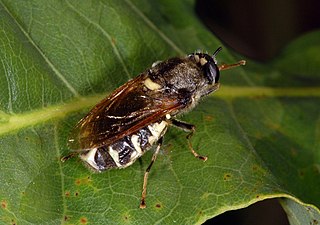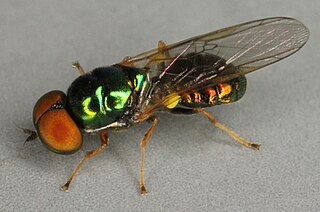
Actina chalybea is a species of 'soldier flies' belonging to the family Stratiomyidae subfamily Beridinae.

Oplodontha viridula, the common green colonel, is a European species of soldier fly.

Stratiomys singularia, the flecked general, is a Palearcticspecies of soldier fly.

Sargus iridatus, the iridescent centurion, is a European species of soldier fly.

Sargus bipunctatus, the twin-spot centurion, is a European species of soldier fly.

Sargus cuprarius, the clouded centurion, is a European species of soldier fly.

Microchrysa flavicornis, the green gem, is a European species of soldier fly.

Microchrysa cyaneiventris, the black gem, is a European species of soldier fly.
Vanoyia tenuicornis, the long-horned soldier, is a European species of soldier fly.
Oxycera analis, the dark-winged soldier, is a species of soldier fly.

Oxycera pardalina, the hill soldier, is a European species of soldier fly.

Oxycera leonina, the twin-spotted major, is a European species of soldier fly.
Oxycera fallenii, the Irish major, is a Palearctic species of soldier fly. The body length is 7.0 to 9.0.mm. The abdomen has three pairs of yellow spots, in addition to a yellow base and tip. Longitudinal stripes on the mesonotum are not connected with the yellow humeral spot. The legs are entirely yellow. This species is found in South European USSR East to Siberia and Western Europe to Ireland, Central Europe, South Europe and Turkey.

Nemotelus uliginosus, the barred snout, is a Palearctic species of soldier fly.

Nemotelus notatus, the flecked snout, is a European species of soldier fly.

Nemotelus is a genus of soldier flies in the family Stratiomyidae. Nemotelus is known from the Nearctic, Afrotropical and the Palaearctic regions.

Beris vallata, the orange legionnaire or common orange legionnaire, is a European species of soldier fly.

Beris fuscipes, the short-horned black legionnaire, is a European species of soldier fly.

Beris geniculata, the long-horned black legionnaire, is a European species of soldier fly.

Brachyopa diversa , the pale-striped sapeater, is a rare species of syrphid fly. It has been observed in the northeastern part of North America. Hoverflies get their names from the ability to remain nearly motionless while in flight. The adults are also known as flower flies for they are commonly found around and on flowers, from which they get both energy-giving nectar and protein-rich pollen. Larvae for this genus are of the rat-tailed type. B.diversa larvae have not been described.
















